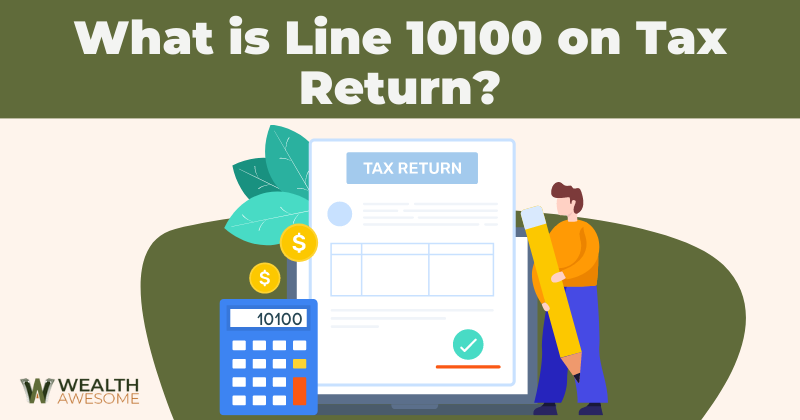Filling out tax returns can be a bit tricky and complicated. For most people, April can be more stressful than it really has to be.
Let’s go over a very common question regarding Canadian tax returns: “What is line 10100 on a tax return in Canada?”
Line 10100 is a section where you enter your employment income from the previous year. This includes the aggregate of all your salaries and wages, commissions, tips, bonuses, and honorariums from all of your income streams.
Usually, one’s employment income is shown in box 14 of the T4 slip they receive from their employer.
What Is Line 10100 (formerly 101) On Your Tax Return in Canada?
Up until the 2019 tax year, Line 10100 used to be numbered 101. Some people may still refer to it as line 101. However, the correct corresponding line number is now 10100.
This is a section on your annual tax return form indicating your employment income details for the tax year you are reporting. Canadian tax years run from January to December.
For most people, this line will simply include income from all T4 slips you receive from your employer(s). You can find your total employment income from a given employer in box 14 of your T4 slip. If you worked multiple jobs in a given tax year, the sum of your box 14 amounts from all T4 slips will make up your line 10100.
By law, all businesses that have employees must file their T4 information with the CRA and distribute employee T4 slips on or before the last day of February (following the calendar year to which the information return applies).
If the last day of February falls on a weekend or holiday, the T4 slips will be due the next business day.
It’s important to note that line 10100 is your income from employment (whether it’s regular or self-employment) and does not necessarily represent your total income for a tax year.
Your total gross income will be written on line 15000 of your tax return, which includes things such as your rental income, taxable scholarships or bursaries, investment income, RRSP income, Old Age Security (OAS), Guaranteed Income Supplement (GIS), Employment Insurance (EI), or other sources of taxable incomes.
Failure to report the entirety of your taxable income on line 10100 and/or line 15000 of your tax return may result in penalties and/or interest charges on your unpaid tax balance.
Distinguishing Wage-Loss Replacement
In some cases, you may receive wage-loss replacement payments from your employer or an insurance company. These payments are designed to cover lost wages due to illness or injury, and are considered taxable income in Canada. However, they are not included in your regular employment income reported on line 10100.
When reporting wage-loss replacement payments, you will need to include these amounts on a separate line on your income tax return to differentiate between your regular employment income and taxable replacement income.
Knowing About Tips and Gratuities
Tips and gratuities are generally categorized into three types: controlled, direct, and declared. Each type is considered taxable income and should be reported on your tax return.
By declaring your tips, you not only remain compliant with tax regulations, but it can also benefit you in terms of increasing your RRSP contribution room, pension, and qualifying for loans and mortgages.
Identifying Unusual Earnings
In addition to your regular salary or wages, your Line 10100 on your tax return in Canada may include some unusual or less common forms of employment income.
As a researcher, you might receive research grants which are considered employment income. Royalties are another type of income that should be reported on Line 10100. If you have created a copyrighted work, such as a book, software, or artistic piece, you may receive royalty payments for its use.
There may also be other employment income that you should include on Line 10100. This income can come in various forms, such as bonuses, tips, or lump-sum payments.
Canadian Tax Returns: How to Submit
As you may already know, a tax return in Canada refers to the mandatory forms that must be prepared and sent to the Canada Revenue Agency (CRA) each financial year by individuals and corporations earning an income.
Your tax return must include information on your employment or self-employed income, foreign investment income, income from assets, or other earnings. You must also include any details regarding your tax deductions, credits, paid tax installments, and expenses.
You can submit your taxes either digitally or manually by mail. After being assessed by the CRA, you may be required to pay additional taxes (if you have underpaid in a given tax year) or get a tax return (if you have overpaid in a given tax year), depending on your total income and eligible deductions.
It is possible to complete your tax return on your own, get digital help, or hire a licensed accountant. However, the two latter will usually have a fee associated with them, ranging from $40 to a couple of hundred dollars.
If you do hire a professional, do note that you will have to supply them with the necessary information to do their job correctly, such as your T4 slips, self-employment earnings, investment incomes, and more.
The CRA will usually have your notice of assessment (NOA) ready in about two weeks after you file your taxes. This statement will include a summary of the amount of income tax you may owe or be owed, tax credit, paid tax installments, and more.
Frequently Asked Questions
How do I locate line 10100 on my T4?
To find your line 10100 employment income on your T4 slip, look for box 14, which shows the total income you earned from your employer within the tax year. Your T4 slip also provides other relevant information, such as deductions and withheld taxes. Employers generally provide these slips for employees by the end of February each year.
Is line 10100 the same as 23600 on the tax return?
No, line 10100 and line 23600 on your tax return are not the same. While line 10100 refers to your employment income, line 23600 represents your net income, which is the total of all your incomes (including line 10100) minus deductions.
What’s the difference between lines 10100 and 10400?
Line 10100 reports your employment income, which includes your salary, wages, commissions, bonuses, tips, gratuities, and honoraria. On the other hand, line 10400 pertains to other employment income not reported on your T4 slip, such as payments from occasional jobs, casual employment, or certain types of self-employment income that don’t require a T4 slip.
Line 10100 is a component of line 15000. Line 15000, formerly known as Line 150, is your total income, which comprises all the types of income you earned within the tax year.
This includes line 10100 (employment income), investment income, rental income, and more. Your total income on line 15000 affects your overall tax calculation and subsequent deductions or credits you may be eligible for.
Is Line 10100 Net or Gross?
Line 10100 indicates an individual’s gross employment income.
As mentioned, line 10100 should contain the aggregated numbers from box 14 of your T4 slips, which indicates your gross, pre-tax employment income from a given employer. As such, line 101 on your tax return is your total employment income before any deductions.
A little reminder that one’s gross income is their earnings before any deductions or taxes. Their net income, on the other hand, is always the same or less than their gross income, as it will have the total tax they owe for the given tax year deducted from their gross income. That is:
Net Income = Gross Income – Taxes
Conclusion

Line 10100 is where you indicate your income from employment on your tax return. Line 15000, on the other hand, indicates your income from all income-generating sources, whether it’s investments, self-employment, or RRSP income.
In my opinion, the best way to up your employment income is through side hustles. Check out this post on the best side-hustles you can take up in Canada to supplement yours.




